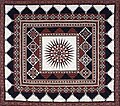Hawaiian quilt
A Hawaiian quilt is a distinctive quilting style of the Hawaiian Islands that uses large radially symmetric applique patterns. Motifs often work stylized botanical designs in bold colors on a white background.

Technique
Hawaiian quilt applique is made from a single cut on folded fabric. Quilting stitches normally follow the contours of the applique design.
History
Hawaiian quilting derives from the kapa moe, an indigenous bed cover textile. Kapa was constructed from the inner bark of local trees. Traditional kapa was beaten and felted, then dyed in geometric patterns.
Quilting may have begun in the Hawaiian islands with the arrival of missionaries and Western fabrics in the 1820s. The climate of Hawaii is unsuitable for cotton cultivation and kapa is unsuitable for quilting so all Hawaiian quilts are constructed from imported material. The earliest written reference comes from Isabella Bird who visited Hawaii in 1870 and wrote a travelogue Six Months in the Sandwich Islands.
Flag quilts
Another Hawaiian quilt style incorporates multiple copies of the Hawaiian flag and commemorate the state's former independence as a sovereign kingdom.
Value

Antique flag quilts fetch higher prices than applique quilts: high quality flag quilts may be valued at $40,000 - $60,000 while applique quilts sell for $9000 - $15,000. Factors that affect price include the quality of the original construction, preservation of the item's color and physical integrity, and provenance.[1]
References
- ^ "Why Hawaiian Quilts?" Antiques Road Show[1]

